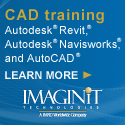
|
www.agc.org Contact Us Archives/Subscribe Advertise IT Forum IT Forum Steering Committee |
Behind-the-Scenes SpotlightAs evidenced by the RFI demonstration that took place at AGC of America's 95th Annual Convention in March, the agcXML initiative takes dedication, hard work and commitment. And, as it picks up steam and adds more schemata to its platform, the behind-the-scene activity will increase as well. This is the second of a series of interviews, highlighting the importance of agcXML and the folks working to make it happen. Q&A with Todd Juhnke Regional Sales Manager Sage Construction and Real Estate Q: Please provide career information for yourself.
I have been at Sage for nearly 11 years. I started my career at Timberline in support. After 18 months, I transitioned into a sales and channel management role, where I have been for nearly a decade.
Q: Describe agcXML as if you were speaking to a non-computer person.
agcXML is in essence a universal interpreter. It provides a structure that allows completely unique technology platforms to communicate with one another even though the individual systems themselves speak completely different languages.
Q: Why did your company choose to become involved in the agcXML initiative?
We understand that no product or company can be all things to all people in this industry segment – there is a proliferation of technology usage across the market. Sage has over 50,000 customers in the construction industry and even the different technologies that our customers use are very different from one customer to the next. Our customers are continuously looking for ways to become more efficient. The agcXML initiative sets in motion a standard that has the potential to revolutionize the industry as it will offer consumers in this field significant efficiencies. We wanted to be a part of this exciting transformation.
Q: How do you see agcXML transforming the industry?
I see agcXML transforming the industry where GCs and/or CMs will require that all contracting firms bidding on and participating on their projects must use an agcXML compliant system and that all RFIs must be submitted via agcXML standard. As people in the market see the potential and the efficiencies gained using agcXML, they will require it on any projects that they are a part of.
Q: What additional steps do you feel should be taken to spur adoption? What can others, outside of the agcXML team, being doing to ensure agcXML becomes an industry reality?
Once the final standards are announced, I feel as though some of the GC and CM leaders in the industry should publicly pilot the technology in the field. Assuming that the testing goes well, then this could be used to drive wider adoption. As wider and wider adoption occurs, it will force a greater number of technology vendors to comply with the agcXML standard.
Q: Describe your role in the RFI data exchange demo at convention.
I participated in the demo activity as the subcontractor using the Sage 300 Construction and Real Estate product (formerly Sage Timberline Office). We initiated the first RFI in the process.
Q: What was involved in preparing for the demonstration (how much time, travel, etc.)?
There was a significant amount of time and coordination involved in preparing for this demo. There were multiple resources involved – we had product development working on the coding and testing of the solution and the formatting of the data. On my end, I was involved in a number of prep and practice meetings. We started the process by going over what to expect, then quickly went to showing the software, without feeding the information electronically, and finally to feeding the information electronically. We spent about a half day in-person running through lines just like a typical production performance. While the preparation was extensive, I do feel that it was necessary given the significance the team sees this potentially having on the industry.
Q: How do you feel the audience reacted to the data exchange demonstration?
I felt that overall the audience reacted favorably, but I also feel some in the audience did not understand it. I also spent time in the Sage booth at ConExpo and while I was there, I had a few people come by the booth to compliment me on my acting job. I also had a couple others say the skit was pretty funny, but they are "too small for that kind of technology." The notion that a firm is too small for agcXML got my attention – perhaps we should have better explained that agcXML is for everyone – big or small.
Q: What do you see as the biggest obstacle for this initiative?
I see the biggest obstacle being getting all of the technology providers on the same page when it comes to the final agcXML schema. Furthermore, getting the vast majority of technology providers in the market to comply with this initiative is key. The way I look at this is that the majority of the benefits of this initiative fall apart if just one stakeholder in a project does not have technology that is compatible.  Sage was formed in 1981. We provide small and medium-sized organizations with a range of easy-to-use, secure, and efficient business management software and services — from accounting and payroll to enterprise resource planning, customer relationship management, and payments. Our customers receive continuous advice and support through our global network of local experts to help them solve their business problems, giving them the confidence to achieve their business ambitions. Sage has over 6 million customers and more than 12,700 employees in 24 countries covering the UK & Ireland, mainland Europe, North America, South Africa, Australia, Asia, and Brazil. Sage was formed in 1981. We provide small and medium-sized organizations with a range of easy-to-use, secure, and efficient business management software and services — from accounting and payroll to enterprise resource planning, customer relationship management, and payments. Our customers receive continuous advice and support through our global network of local experts to help them solve their business problems, giving them the confidence to achieve their business ambitions. Sage has over 6 million customers and more than 12,700 employees in 24 countries covering the UK & Ireland, mainland Europe, North America, South Africa, Australia, Asia, and Brazil.Sage has been the industry leader in construction and real estate solutions for more than 40 years. From estimating to finances to projects to field to service to property, Sage products cover all phases of construction. We measure our success by our customers’ success. Over 50,000 customers manage more than 500,000 jobs, 7 million subcontracts, and 622,000 rental units each year with Sage products, including: Sage Construction Anywhere, Sage 300 Construction and Real Estate (formerly Sage Timberline Office), Sage 300 Trade Specialty (formerly Sage Timberline Enterprise), Sage Estimating (formerly Sage Timberline Estimating), Sage 100 Contractor (formerly Sage Master Builder) and Sage 50 Construction Accounting (formerly Sage Peachtree Premium Accounting for Construction). Q&A with Blake Hudson
Brasfield & Gorrie
Q: Please provide career information for yourself. I serve as business analyst, prolog administrator and integration owner at Brasfield & Gorrie, L.L.C., responsible for business process analysis, and software design, development and integration. Previously, I served as project manager at various construction firms in the Southeast and worked on projects spanning the institutional, industrial and commercial sectors. I also was head instructor of building construction for a community college in Bessemer, Ala.
Q: Describe agcXML as if you were speaking to a non-computer person. agcXML is an exciting new program designed to remove barriers that prevent the efficient exchange of data between construction contractors and members of project teams. The program offers a common design standard that supports the seamless transfer of data. Also, agcXML works with existing software in an optimal methodology. Adoption and implementation of this standard will enhance collaboration between contractors and project teams and eliminate duplication of data entry in multiple software systems since data elements will be able to pass digitally from one system to another without additional input or action. The program notifies contributors of changes or system updates, enabling all participants to know where and when data has been exchanged, reducing opportunities for miscommunication among the project team.
Also, agcXML allows participants to use their preferred software systems, regardless of size, cost, or complexity. The standard is built from the ground up to accommodate complex data and deliver efficiencies for larger projects as noted, while still capturing those same efficiencies for smaller projects and less complex data also. Simply stated, the new standard will allow small and large project teams to ‘shake hands’ and exchange data using the same methods. Q: Why did your company choose to become involved in the agcXML initiative?
Brasfield & Gorrie has a long history of innovation, and we have worked with many emerging software vendors over the years. This approach has enabled our company to discover and capture efficiencies and advantages that these vendors also were trying to achieve, and it has resulted in wins for both our company and the vendors. Also, Brasfield & Gorrie enjoys a positive relationship with the AGC and we recognize and applaud its efforts to position agcXML as a resource for the construction industry.
Additionally, Brasfield & Gorrie Vice President Tom Garrett serves on an AGC committee that promotes this initiative. Q: How do you see agcXML transforming the industry? There are significant technology benefits for the construction industry. With the inclusion of agcXML into processes, the now onerous task of data entry will become more efficient and contributor-friendly, and should spur even greater collaboration among project teams. This will be a significant benefit because project team members will have the information necessary to process and respond to requests in a more timely manner. Combined with the agcXML’s overall reduced process flow time, this will help transform the industry from a state of "documentation by necessity" to a contribution-driven environment.
Q: What additional steps do you feel should be taken to spur adoption? What can others, outside of the agcXML team, be doing to ensure agcXML becomes an industry reality? The contractor community will be a key influencer in the adoption of agcXML standards. I encourage member contractors to contact their software vendors and encourage them to adopt the standard. It’s essential that contractors tell software vendors about the importance and relevance of this initiative, especially because the technology will improve performance and productivity on many levels.
Q: Describe your role in the RFI data exchange demo at convention. I am fortunate to have been selected by my employer to participate in the agcXML RFI program workgroup, where I teamed with technology and construction professionals to identify workflow, data field needs, and baseline samples. This work was very inspiring and meaningful, and the workgroup members shared a common desire to move the project forward. This collaboration led to the convention presentation where I participated with software vendors in a discussion about this project.
Q: How do you feel the audience reacted to the data exchange demonstration? It was rewarding to experience the audience’s positive reaction to the demonstration that introduced the initiative. So that it would not be perceived as a purely technical presentation, our team interjected humor where possible. Also, multiple large screen monitors were stationed throughout the room to help the audience see the interoperability of the various software programs. Judging the overall response, there seemed little question that the industry is eager for this new technology. Following the presentation, audience members congratulated the panelists for the presentation and they expressed appreciation to AGC for pursuing this effort.
Q: Were there questions raised by audience members that hadn’t been addressed by the agcXML team? If so, what were they and will they be addressed in the future? One of the most memorable questions was about file attachments, which is not an exclusive issue to agcXML. Large file attachments often pose a challenge for some software systems to digest; however, the RFI program schema is built to accommodate by design. The answer to this dilemma rests with each contractor’s IT infrastructure. I believe that as technology progresses, this issue will diminish. Q: What do you see as the biggest obstacle for this initiative? Contractors must demand this technology as a means to enhance the success of their projects. They must let software vendors know how important it is to the future of our industry. Beyond construction, design team participants, and other consultants must adopt and promote this standard among their software vendors. All team members have a role to play in the successful adoption of this initiative.
 Celebrating 50 years in business this year, Brasfield & Gorrie is one of the nation's largest privately held construction firms, providing general contracting, design-build, and construction management services for a wide variety of markets, including healthcare, commercial, institutional, federal, municipal, industrial, infrastructure, and water/wastewater treatment. Clients are served from our offices in Atlanta and Columbus, Ga.; Birmingham, Ala.; Dallas, Texas; Jacksonville and Orlando, Fla.; Nashville, Tenn.; and Raleigh, N.C. Brasfield & Gorrie has approximately 2,600 employees, and its 2013 revenues were $2.3 billion. Celebrating 50 years in business this year, Brasfield & Gorrie is one of the nation's largest privately held construction firms, providing general contracting, design-build, and construction management services for a wide variety of markets, including healthcare, commercial, institutional, federal, municipal, industrial, infrastructure, and water/wastewater treatment. Clients are served from our offices in Atlanta and Columbus, Ga.; Birmingham, Ala.; Dallas, Texas; Jacksonville and Orlando, Fla.; Nashville, Tenn.; and Raleigh, N.C. Brasfield & Gorrie has approximately 2,600 employees, and its 2013 revenues were $2.3 billion.Q&A with Derek Leaver Group Deputy Chairman and Chief Executive - USA COINS Q: Please provide career information for yourself. Q: Describe agcXML as if you were speaking to a non-computer person. The intention is to get data from one system to another. Pretty much everyone understands that you can send a file from one computer to another, the trick for real integration is to get the data in that file directly from one software package into another without having to re-type information or ‘hand crank’ the data out of one system and into another. It’s like the difference between have a washing machine delivered to your front door for you to sort out and having it delivered right into your laundry room, connected, plumbed in and ready to go. Q: Why did your company choose to become involved in the agcXML initiative?
We have been involved in data integration for a long time. Functions such as sending purchase orders directly into suppliers’ sales systems, or receiving invoices directly into the AP system, or sending payments directly to bank systems are pretty commonplace these days. Linking mobile data or voice recognition systems to our systems are also increasingly common. However, I once read a survey that stated more money was spent in trying to integrate software systems than on the software systems themselves — in my view that’s a huge waste of time and money. It shouldn’t be that difficult. We are always happy to support any initiative that can make life easier for our clients and the industry at large, and working with organizations like the AGC should help that cause.
Q: What additional steps do you feel should be taken to spur adoption? Giving end users an easy way of using agcXML is the key. People generally tend to stick with what they know and avoid change if they can, so if it’s ‘easy’ to fax, email or post information, they will continue to do that. Sending information (agcXML) between systems needs to be simple to use and reliable. Many of the parties in the process that will need to touch the data (i.e., get it or send it) will have relatively small IT systems and budgets, simply because they are smaller companies, so making this cost effective for them is also the challenge. The agcXML file format is the easy bit. Transmitting the data and being sure it got there is what will separate the software vendors and determine the uptake of this kind of data integration. Given our success in this area in other parts of the world, I think we are well placed to help North American clients to grow the proportion of their business that happens electronically, with the subsequent cost savings and efficiency gains.
Q: What do you see as the biggest obstacle for this initiative? Primarily it’s that many of the parties involved will be fairly small and without IT departments, so managing the sending and receiving of data to multiple parties and various projects could be prohibitive unless it is made very, very easy. There will also be a requirement to translate data somewhere along the line (e.g., Project 1234 on my system is Project ABCD on yours) and people with little or no experience in data interchange may struggle to find an automatic solution to overcome this.  COINS has been around for 30 years and works exclusively in the various vertical markets within the construction sector. This includes construction, heavy highway, homebuilding, specialty and equipment contractors, plus some areas of the supply chain. Most of our clients are ‘’mid-to-top end’’ and the scope of COINS is broad and often described as ‘’ERP for construction’’ and spans the construction process from ‘’design to demolition,’, addressing all areas of procurement, suppliers, subcontractors, payroll/HR, CRM, equipment, service management, facilities management, 3D design and BIM, as well as the obvious full range of project and job costing and financial systems, plus associated business analytics and mobile applications. We see ourselves largely as a one stop shop offering our clients real integrated systems to support their businesses, anywhere in the world with, if required, multilingual and multi-currency capabilities. We prefer to have long-term and close-working relationships with our clients, rather than chase for large volumes of clients with just a transactional relationship. COINS has been around for 30 years and works exclusively in the various vertical markets within the construction sector. This includes construction, heavy highway, homebuilding, specialty and equipment contractors, plus some areas of the supply chain. Most of our clients are ‘’mid-to-top end’’ and the scope of COINS is broad and often described as ‘’ERP for construction’’ and spans the construction process from ‘’design to demolition,’, addressing all areas of procurement, suppliers, subcontractors, payroll/HR, CRM, equipment, service management, facilities management, 3D design and BIM, as well as the obvious full range of project and job costing and financial systems, plus associated business analytics and mobile applications. We see ourselves largely as a one stop shop offering our clients real integrated systems to support their businesses, anywhere in the world with, if required, multilingual and multi-currency capabilities. We prefer to have long-term and close-working relationships with our clients, rather than chase for large volumes of clients with just a transactional relationship. |

2300 Wilson Boulevard, Suite 300 · Arlington, VA 22201 · 703-548-3118 (phone) · 703-548-3119 (fax) · www.agc.org
About AGC | Advocacy | Industry Topics | Programs and Events | Career Development | News & Media
© Copyright 2025 The Associated General Contractors of America. All rights reserved.

